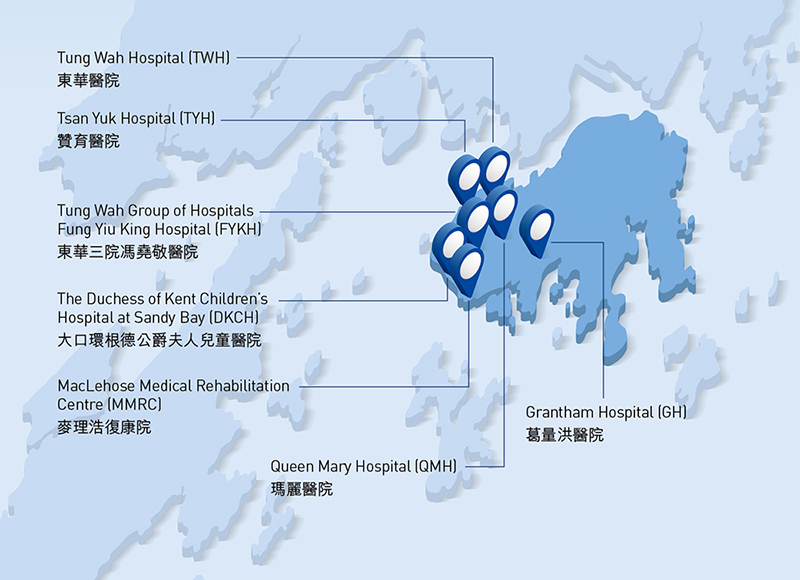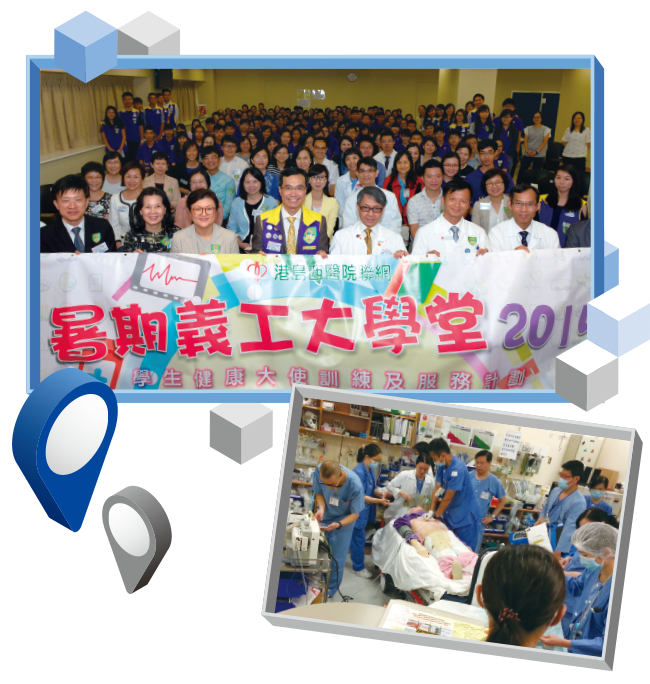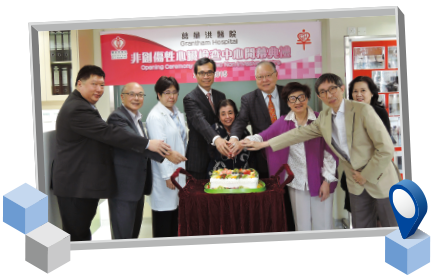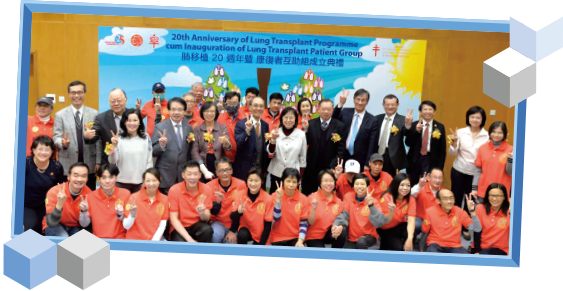Hong Kong West Cluster (HKWC)

| Number of general outpatient clinics | 6 |
| Throughput | |
| Number of beds | 3,142 |
| Patient discharges* | 202,584 |
| A&E attendances | 128,503 |
| Specialist outpatient attendances (clinical) | 872,166 |
| General outpatient attendances | 388,650 |
| Full-time equivalent staff | 8,035 |
* Total inpatient, day patient discharges and deaths
HKWC has been continuously fostering a close partnership with Li Ka Shing Faculty of Medicine of the University of Hong Kong in the support of undergraduate and postgraduate medical education, training, research and development, as well as innovation in healthcare technology and services. The redevelopment of QMH is one step further to foster future collaboration.
Manpower shortage remained one of the main concerns to HKWC when considering service enhancement initiatives. To allay staff shortage, nursing manpower was strengthened to meet operational needs at acute settings and high pressure areas. Additional allied health professionals were also recruited to enhance support for patients requiring multi-disciplinary care and rehabilitation. Further, patient care assistants were recruited to share out simple clinical tasks and relieve clerical workload of allied health professionals.

Service capacity for high demand life threatening diseases, including end-stage renal disease, respiratory disease, cancer, stroke and heart disease were increased through technological advancement, care model coordination, transplantation and long-term ventilator care. These included enhancing the capacity of renal replacement therapy for patients with end-stage renal disease by providing hospital haemodialysis treatment to two additional patients, home haemodialysis treatment to five additional patients and home automated peritoneal dialysis treatment to two additional patients. QMH, being the first hospital to use this innovation in Hong Kong, has enhanced the capacity of Extracorporeal Membrane Oxygenation (ECMO) service with the launch of a pilot programme to use ECMO together with cardiopulmonary resuscitation (CPR) at the same time for saving patients with cardiac arrest. In addition, QMH imported a new technology, namely ex-vivo lung perfusion (EVLP), to increase availability of donor lungs.
In order to enhance service capacity of heart disease, the newly renovated Cardiac Non-Invasive Centre at GH provided comprehensive diagnostic services, including cardiac echocardiography services (both transthoracic and transesophageal echocardiography), exercise treadmill testing, cardio-pulmonary stress testing, cardiac arrhythmia diagnostic centre (including 24-hour Holter monitoring, cardiac event monitoring and remote monitoring service of implantable cardiac devices).
In addition, DKCH moved further by providing four additional rehabilitation beds for children requiring long-term use of ventilators. Subsequent to the smooth implementation of Phase one of the Integrated Chinese-Western Medicine Pilot Programme for stroke care since September 2014, TWH started the Phase two programme in December 2015.
Accessibility to services with pressing issues of waiting time was improved by increasing the capacity of endoscopy service, lung function laboratory service and MRI service. For example, an MRI machine was added in QMH to provide 344 additional investigations. The waiting list of endoscopy services was better managed by providing around 570 additional endoscopic procedures. Besides, the Community Geriatric Assessment Team service was strengthened to reduce unnecessary admissions from residential care homes for the elderly.
Service models with enhanced safety were developed. The surgical instrument tracking system was further rolled out to GH to support improved sterilisation service for operating theatres. Re-use of selected types of single use device according to clinical risk prioritisation was phased out. In pursuit of continuous quality improvement and patient safety, DKCH, FYKH, GH, and MMRC had embarked on the journey of preparing the hospitals for accreditation.
To keep abreast of modern clinical practices, minimal invasive surgery technique in hysterectomy surgeries was adopted for suitable gynaecological patients in QMH. The management of cancer and blood cancer patients was modernised through improving molecular tests and high-technology radiation therapy in QMH by recruiting talents and upgrading their skills. Besides, with the new Computer-aided Design and Manufacturing System, DKCH has shortened the time for tailor-making braces for teenagers with scoliosis.
The central coordinated refill service for medical consumables, Personal Protective Equipment, Central Sterile Supply Department and linen items in hospital wards was rolled out. HKWC adopted a patient-centred approach in communication with patients and carers by improving and streamlining the phone enquiry services at specialist outpatient clinics.


